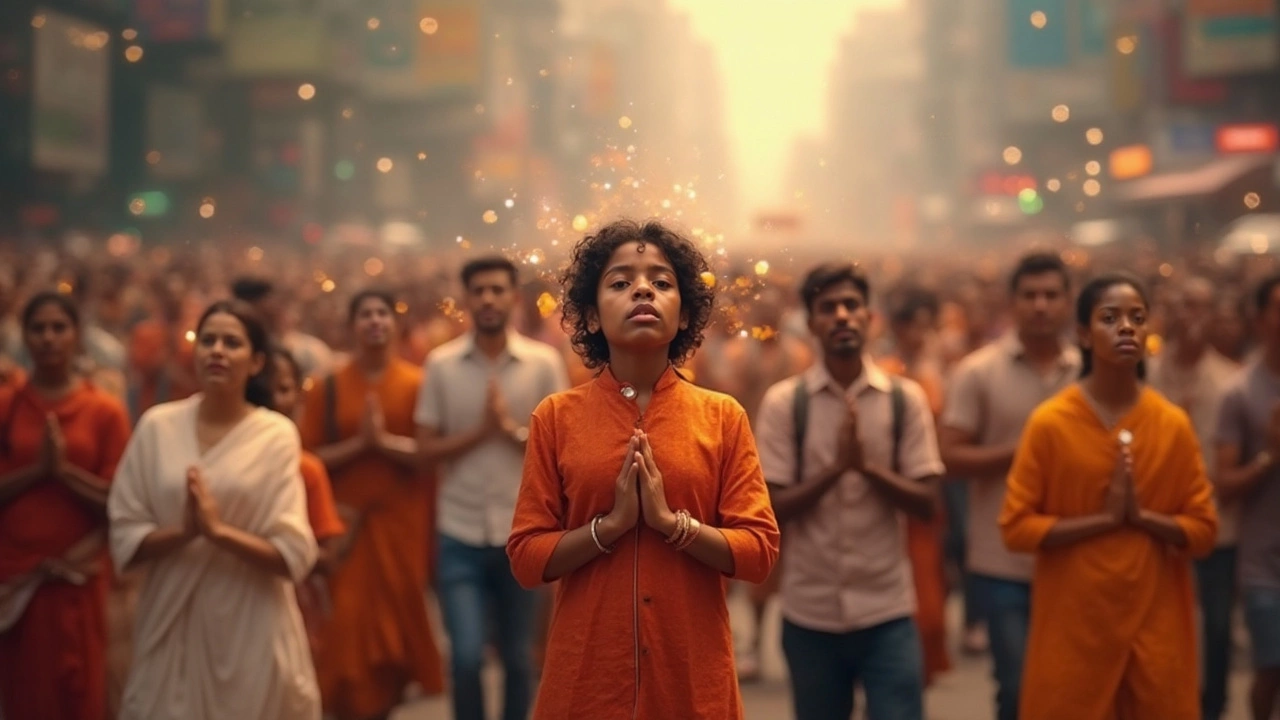Ever heard the words “Om Shanti Shanti Shanti” and wondered what it’s all about? This short Hindu chant actually sits at the heart of most Indian prayers and rituals. It's not just a couple of pretty words—it's a direct request for real peace, in your mind, your surroundings, and in the world beyond. You don’t need to go to a temple or know Sanskrit to benefit from it.
What’s cool is, this isn’t just some old tradition that only priests care about. Even busy families, like mine—with a noisy kid named Rohan and a dog that barks whenever the doorbell rings—use this mantra to pause and reset. Whether I’m having a rough day or Max is chewing up my shoes, a quick “Om Shanti” helps me get my head on straight.
If you’re looking for something that’s simple, doesn’t require fancy tools, and can get you back to calm in the middle of chaos, the Shanti mantra deserves a try. No complicated setup, no big financial investment. Just some honest words repeated with intent—and you might notice the buzzing in your head quiets down, at least for a little while.
- The Famous Shanti Mantra: What It Is
- Decoding the Words: Simple Meaning Explained
- Why Chant for Peace? Everyday Impact
- How to Chant: Easy Steps for Beginners
- Tips to Make It a Daily Habit
The Famous Shanti Mantra: What It Is
So, what exactly is the Shanti mantra? It’s actually a set of ancient Sanskrit chants, recited across India, especially in Hindu rituals and spiritual gatherings. The word “Shanti” translates to peace, and you’ll hear the mantra at the start and end of a lot of Hindu prayers, yoga routines, and even school assemblies. The classic form goes: “Om Shanti Shanti Shanti.” Some ceremonies might use the longer “Om Sahana Vavatu…” version, but the theme is always peace on all fronts.
You might be surprised to know that this mantra isn’t tied to any single god or festival. Instead, it’s something of a universal “reset button,” cutting across different beliefs and traditions in India. The most important Hindu chant for peace, it asks for calmness and well-being, not just for you, but for everyone and everything around you.
Now, here’s a neat breakdown of where you’ll bump into the Shanti mantra in regular life:
- Morning or evening prayer rituals at home
- Yoga and meditation classes (many start or end with it)
- Big family functions like weddings or baby namings
- Indian schools or colleges during group assemblies
- TV shows and movies showing cultural scenes
This table gives a quick sense of how often the Shanti mantra gets used in different settings:
| Place/Occasion | Typical Frequency |
|---|---|
| Household prayers | Nearly every day |
| Yoga studios | Multiple times a week |
| Religious ceremonies | Always included |
| Schools in India | At least once a week |
| Indian movies & TV | Common in cultural scenes |
It’s one of those rare spiritual tools that isn’t “reserved” for experts or monks—anyone can say it, anytime. Whether you’re feeling stressed, want to start your day right, or just need a moment to pause, this mantra fits the bill. No wonder it’s stuck around for thousands of years.
Decoding the Words: Simple Meaning Explained
If you stop anyone in India and ask about the Hindu chant for peace, you’ll usually hear the phrase "Om Shanti Shanti Shanti." It sounds simple, but there’s a deep meaning packed into those few words. "Om" is the sound believed to connect our minds to something bigger, like hitting the reset button inside your head. The word "Shanti" means peace, and it’s repeated three times—not just for effect, but for a reason that actually makes sense when you hear it broken down.
Here’s what each part stands for:
- First Shanti: Asking for peace in the natural world—like the weather, environment, or anything outside us that could disturb our calm.
- Second Shanti: Looking for peace in our physical bodies or between people—so there’s less conflict and sickness in life.
- Third Shanti: Praying for peace in your own mind. This one's about silencing the non-stop chatter or anxiety inside your head.
So, saying this chant isn’t just wishful thinking or ritual habit. You’re specifically reminding yourself to create peace in every layer—outside, around you, and inside you. People use this mantra before starting classes, after finishing prayers, and even before making big decisions. Indian schools, yoga classes, and family gatherings often start or end with it because it’s quick and easy to remember, but actually covers all the bases where stress could show up.
Here’s how the mantra is written in Sanskrit and its common translation:
| Sanskrit | English Translation |
|---|---|
| ॐ शान्तिः शान्तिः शान्तिः | Om, peace, peace, peace |
This is probably why you’ll see the Shanti mantra on temple walls, in modern meditation apps, and even pop up in Bollywood movies when a moment of calm is needed. It's just three phrases, but you’re basically requesting the universe for full-coverage peace every time you say it.

Why Chant for Peace? Everyday Impact
Ever noticed how hectic mornings or endless work calls can leave your brain feeling scrambled? The idea behind using a Hindu chant for peace is actually super practical. These chants, especially the Shanti mantra, are meant to help people get grounded and let go of stress—no matter what’s going on around them. It’s not just myth; there’s solid research showing that repeating short prayers or mantras can slow heart rate, lower blood pressure, and even improve focus. A study done at Harvard found that repeating any simple phrase or sound—like "Om" or "Shanti"—can reduce anxiety levels in just a few minutes.
People from all sorts of backgrounds use these chants to reset. For example, school kids in India often recite the Shanti mantra before classes. Offices and even online meetings sometimes start with it now, just to set a calmer vibe. I’ve seen my son Rohan get fidgety with homework, and sometimes, a quick chant and a deep breath actually help him sit still for longer.
Here’s what studies and real people see from making this chant a habit:
- Calmer moods, especially during stressful days
- Better sleep patterns when chanting before bed
- Improved focus and fewer distractions
- Even a friendlier family vibe—arguments cool down quicker
If you're wondering how it stacks up with other methods, check out this quick comparison:
| Practice | Time Needed | Main Benefit |
|---|---|---|
| Shanti Mantra | 2-5 min | Quick calm, easy focus |
| Yoga Session | 30-60 min | Physical & mental calm |
| Meditation | 10-20 min | Deep quiet, less anxiety |
No need for incense or chanting out loud if you don’t want to. Just reciting in your head does the trick. That makes it perfect for people who are on the go, have roommates, or (like me) have a mischievous dog crashing every quiet moment!
How to Chant: Easy Steps for Beginners
Diving into the Hindu chant for peace is honestly a lot less complicated than people think. You don’t have to memorize long verses or be a spiritual master. The Shanti mantra is meant for everyone, including absolute beginners. Here’s how you can start, no matter where you are:
- Find a quiet-ish spot: It doesn’t need to be perfectly silent. Even a corner in your living room will work. Pets and kids can be around; just do your best to focus.
- Get comfortable: You can sit cross-legged on the floor like people do in yoga, but honestly, a chair works fine. Keep your spine fairly straight and relax your shoulders.
- Close your eyes (optional): Some people like keeping their eyes open with a soft gaze. Try both—see what works for you.
- Breathe naturally: Take a couple of slow, deep breaths. It’s about getting your mind to chill out for a second before you start.
- Chant the words: Say the mantra out loud or in your head: “Om Shanti Shanti Shanti.” It’s usually repeated three times in a row.
- Notice what you feel: Don’t force yourself to feel ‘zen’ or calm right away. Just notice if you feel even a little bit lighter or clearer after chanting.
If you want to dive deeper, check out what studies suggest: chanting can actually send signals to your brain to slow down and relax. A study by Harvard in 2018 found that repeating short mantras—even for newbies—helped lower anxiety and improved focus in real-world situations. Not too shabby for something that takes less than a minute.
| Frequency | Percentage |
|---|---|
| Once Daily | 35% |
| Several Times a Week | 25% |
| Only During Stressful Situations | 30% |
| Rarely or for Rituals | 10% |
Short on time? Even one round in the car before work or after dinner makes a difference. You don’t have to be perfect. Just give yourself a minute to try, and see if it helps you hit reset.

Tips to Make It a Daily Habit
Building a habit around chanting the Hindu chant for peace doesn’t mean you need hours of free time or perfect silence. Real life is messy—kids argue, phones buzz, dogs bark (trust me, I know). The trick is to keep things simple so it actually sticks.
Here’s what’s worked at my place, and for plenty of others I know:
- Pick Your Moment: The Shanti mantra works best when you tie it to something you already do. Maybe you say it before your morning coffee, after you brush your teeth, or right before bed. It just takes a minute or two.
- Keep It Short: You don’t need to chant for half an hour. Start with three slow rounds of “Om Shanti Shanti Shanti” and see how that feels. Even once is better than skipping it.
- Post a Reminder: I put a sticky note on the bathroom mirror for a while (“Chant Shanti!”). Some people set a daily alarm on their phone.
- Make It a Family Thing: Kids often love routines, and mine follows along just for the fun sounds. If everyone joins in—even for just one round—it helps build consistency.
- Take It on the Go: If I get stuck in traffic or a stressful moment at work, I just repeat it quietly in my head. No one even notices, but it helps me calm down and refocus.
There’s no need to get hung up on perfection. Consistency matters way more than chanting with the right pronunciation or setting up a fancy space. By connecting the mantra to something you already do every day, you’ll find it slips into your life pretty naturally. And honestly, the sense of calm adds up before you realize it.
